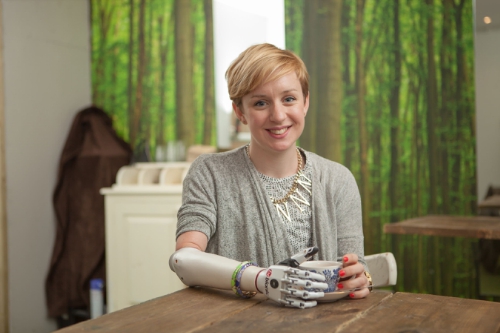Formula 1 inspires bionic breakthrough as most anatomically accurate hand delivers unrivalled level of precision and natural movements for young female user
A congenital amputee from London has become the first user in the UK to be fitted with a new prosthetic hand that launches today and sets a new benchmark in small myoelectric hands. Developed using F1 technology and specifically in scale for women and teenagers*, the bebionic small hand is built around an accurate skeletal structure with miniaturised components designed to provide the most true to life movements.
The bebionic small hand, developed by prosthetic experts Steeper, will enable fundamental improvements in the lives of thousands of amputees across the world. The hand marks a turning point in the world of prosthetics as it perfectly mimics the functions of a real hand via 14 different precision grips.
Nicky Ashwell becomes first UK user
Nicky Ashwell, 29, born without a right hand, received Steeper’s latest innovation at a fitting by London Prosthetics Centre . Before being fitted with the bebionic small hand, Nicky would use a cosmetic hand without movement; as a result, Nicky learned to carry out tasks with one hand. The bebionic small hand has been a major improvement to Nicky’s life, enabling her to do things previously impossible with one hand.
Nicky, who is a Product Manager at an online fashion forecasting and trend service, said, “When I first tried the bebionic small hand it was an exciting and strange feeling; it immediately opened up so many more possibilities for me. I realised that I had been making life challenging for myself when I didn’t need to. The movements now come easily and look natural; I keep finding myself being surprised by the little things, like being able to carry my purse while holding my boyfriend’s hand. I’ve also been able to do things never before possible like riding a bike and lifting weights.”
The technology behind bebionic small hand
Bebionic small hand works using sensors triggered by the user’s muscle movements that connect to individual motors in each finger and powerful microprocessors. The technology comprises a unique system which tracks and senses each finger through its every move – mimicking the functions of a real hand. Development follows seven years of research and manufacturing, including the use of Formula 1 techniques and military technology along with advanced materials including aerograde aluminium and rare Earth magnets.
Help keep news FREE for our readers
Supporting your local community newspaper/online news outlet is crucial now more than ever. If you believe in independent journalism, then consider making a valuable contribution by making a one-time or monthly donation. We operate in rural areas where providing unbiased news can be challenging. Read More About Supporting The West Wales Chronicle























